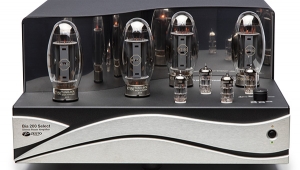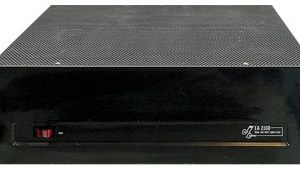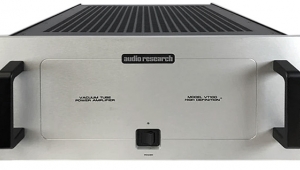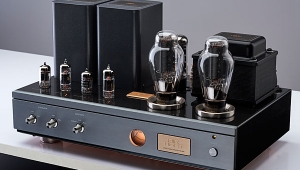| Columns Retired Columns & Blogs |
Audio Research Reference 110 power amplifier Page 2
The second of the 110's remarkable strengths was its ability to render high frequencies with a clean, pristine, extended presentation totally devoid of electronic artifacts. This was also my reaction to the high frequencies of ARC's Reference 3 line-stage preamplifier (see my Follow-Up in the June issue, p.139); in this region, clearly, these two designs were cut from the same sonic cloth. I tested the Reference 110 with both the Reference 3 and Audio Valve Eklipse's line stage, and the amp's high-frequency strengths shone through both (although the effect was notably greater with the ARC preamp). Soloist Tom Chiu's violin in David Chesky's Violin Concerto, on Area 31 (SACD/CD, CD layer, Chesky SACD288), revealed natural but biting extended partials, and the instrument's vibrancy seemed to pop out of thin air. Similarly, Carol Wincenc's flute, in Tomiko Kohjiba's Transmigration of the Soul, from Festival (CD, Stereophile STPH007-2), was appropriately metallic, extended, and airy, with all subtle low-level dynamic inflections intact.
The Reference 110's organic presentation of dynamics made it superb for jazz recordings. On "House Party Starting," from Herbie Nichols' The Complete Blue Note Recordings (CD, Blue Note CDP 8 50352 2), I fixated on the interplay of Max Roach's snare and bass drum with Al McKibbon's woody, warm, and vibrant walking bass line. I'd hoped that, during bombastic dynamic blasts, the Ref 110's over-engineered power supply (520 joules of storage is unusually large for a 110W amp) would make it sound more powerful than it actually is, and the ARC did not disappoint. On John Atkinson's recording of Robert Silverman's performance of Beethoven's 32 piano sonatas (CD, OrpheumMasters KSP830), I listened to the Largo of Sonata 2 in A, Op.2 No.2 (which is one of my favorite pieces to play as well). This delicate work from Beethoven's early twenties has a surprise near the end, when a sudden ff passage bursts forth without warning, using the piano's entire ranges of frequency and dynamics. My listening notes read "thunder, drama, and no strain."
"Mansour's Gift," from my jazz quartet Attention Screen's Live at Merkin Hall (CD, Stereophile STPH018-2) includes huge dynamic swings. Drummer Mark Flynn coaxes a broad range of bombastic colors with soft mallets from his Korean puk drum, and near the end there's a tutti crescendo that tested the dynamic limits of the recording process. The Reference 110 rendered these dynamic swells as we'd created them on the Merkin's stage.
The ARC's ability to render wide dynamic blasts on electronic recordings didn't hamper in any way its ability to render subtle details within these recordings. In Kraftwerk's Minimum/Maximum (CD, EMI ASW 60611), the low- and high-frequency transients were startling, detailed, and lightning-fast without being harsh, even at extreme volume levels, while preserving subtle programming details that I hadn't noticed with other amplifiers. Similarly, Chris Jones' original electronic works, on Snowflake's Tea Lounge 6-04-06 (CD, private recording), blend powerful dynamic bass blasts with delicate kalimba samples—through the ARC 110, all were clear and pristine with no trace of mud or strain.
I had to look really hard to find any shortcomings in the Reference 110, and found only one very small one. With certain recordings, there was a touch of warmth or roundedness in the midbass region. This genuinely split hair—the music still sounded incredibly lifelike—was audible only when I compared the 110 with amplifiers that have an ultrafast, overdamped quality in this region. Ray Brown's bass solo on "I'm an Old Cowhand," on Sonny Rollins' Way Out West (CD, JVC VICJ 60088), was extremely natural, but a touch warm only near the bottom of the instrument's register. Similarly, the midbass synth lines on Sade's Love Deluxe (CD, Epic EK 53178) were natural but just a touch rounded.
Jerome Harris' arrangement of Duke Ellington's "The Mooche," on Editor's Choice (CD, Stereophile STPH016-2), put all of the 110's strengths together. The blend of alto sax and trombone was the silkiest I've ever heard from this track, and the musicians sounded as if they were in my room (or, more appropriately, as if I were in the recording venue, the recycled church sanctuary of Chad Kassem's Blue Heaven Studios). My notes: "this amp blooms like nothing I have ever heard; I want to listen longer and longer." I've never heard a male voice sound more natural than Hugh Masekela's through the Reference 110, in his rendition of "Stimela (The Coal Train)," on Hope (CD, Triloka KAT 2020-2). Moreover, the natural dynamics of the percussion on this live pop recording, and the bite and burnished brass of Masekela's trumpet, were startling.
Comparisons
I spent many days comparing the Reference 110 with ARC's own VT100 Mk.II. Both amps drove my Alán Circe speakers, and I listened to both with my Audio Valve Eklipse and ARC's Reference 3 line stages. I gave very favorable reviews in Stereophile to both the VT100 Mk.I (March 1997, Vol.20 No.3) and Mk.II (December 1998, Vol.21 No.12), and I still cherish this amplifier. It does everything I want an amp to do: a detailed, natural, dynamic performer with a broad range of recordings, it has exhibited no shortcomings, no colorations, and no flaws in the many years it's resided in my reference system. To exceed such performance would be a tall order.
The Reference 110 filled that order, and by a wide margin. It revealed far more inner detail than the VT100 Mk.II, and with more air, ambience, dimensionality, and a greater sense of organic drama and ease. The Ref 110 seemed to turn up the VT100 Mk.II's greatest strengths a notch or two. In the greatest difference between the two ARC amps, the Ref 110 highlighted a flaw in the VT100 that I'd never noticed before. The 110's high frequencies were so pure, so extended, and so detailed that, by comparison, the VT100's highs seemed surrounded by a slight electronic haze. In vocal recordings, sibilants were not as detailed or as pure through the VT100; and in well-recorded classical works, the balance of bow rosin and wood in violin passages seemed more skewed toward the rosin. The low- and high-level dynamic performances of both amps were exceptional. They sounded much more powerful than their ratings of 100W and 110W would indicate.
Only in one area did I feel that the VT100 Mk.II exceeded the performance of the Reference 110: The VT100 lacked that very slightly warm and rounded quality I heard in the Ref 110. By comparison, the VT100 had a tight, dynamic, kick-slam quality in the midbass that reminded me of a high-quality solid-state amp. But I'm splitting hairs again—both amps were exceptionally realistic in the bottom three octaves.
Summing up
The Audio Research Corporation's Reference 110 amplifier replicated, over many weeks of listening, the magic I'd experienced in those few hours of listening at Home Entertainment 2006. In certain areas the amplifier produced a level of realism startling enough to make me reluctant to turn the stereo off. I had this experience with all types of music, as well as with movies. Although the 110 was an excellent match for ARC's Reference 3 preamp, I didn't need an ARC preamp to hear its magic.
Those who've read my reviews for a while know that I rarely change reference components. In fact, at one point about 10 years ago, every piece of gear in my reference system had been discontinued. For me to even consider buying it, a new product must constitute a significant improvement over what I already own, as well as provide value for money. At the end of my listening sessions for the Reference 110, I put down my notebook and picked up my checkbook. This amplifier is not going back to ARC.
- Log in or register to post comments



































